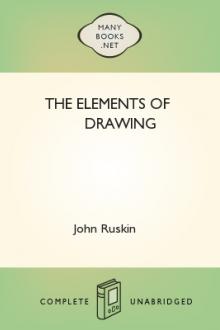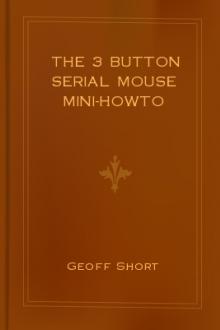The Elements of Drawing by John Ruskin (smart books to read .txt) 📕

xii. One task, however, of some difficulty, the student will find I have not imposed upon him: namely, learning the laws of perspective. It would be worth while to learn them, if he could do so easily; but without a master's help, and in the way perspective is at present explained in treatises, the difficulty is greater than the gain. For perspective is not of the slighte
Read free book «The Elements of Drawing by John Ruskin (smart books to read .txt) 📕» - read online or download for free at americanlibrarybooks.com
- Author: John Ruskin
- Performer: -
Read book online «The Elements of Drawing by John Ruskin (smart books to read .txt) 📕». Author - John Ruskin
ix. That labor is, nevertheless, sufficiently irksome, nor is it possible that it should be otherwise, so long as the pupil works unassisted by a master. For the smooth and straight road which admits unembarrassed progress must, I fear, be dull as well as smooth; and the hedges need to be close and trim when there is no guide to warn or bring back the erring traveler. The system followed in this work will, therefore, at first, surprise somewhat sorrowfully those who are familiar with the practice of our class at the Working Men's College; for there, the pupil, having the master at his side to extricate him from such embarrassments as his first efforts may lead into, is at once set to draw from a solid object, and soon finds entertainment in his efforts and interest in his difficulties. Of course the simplest object which it is possible to set before the eye is a sphere; and, practically, I find a child's toy, a white leather ball, better than anything else; as the gradations on balls of plaster of Paris, which I use sometimes to try the strength of pupils who have had previous practice, are a little too delicate for a beginner to perceive. It has been objected that a circle, or the outline of a sphere, is one of the most difficult of all lines to draw. It is so;[A] but I do not want it to be drawn. All that his study of the ball is to teach the pupil, is the way in which shade gives the appearance of projection. This he learns most satisfactorily from a sphere; because any solid form, terminated by straight lines or flat surfaces, owes some of its appearance of projection to its perspective; but in the sphere, what, without shade, was a flat circle, becomes, merely by the added shade, the image of a solid ball; and this fact is just as striking to the learner, whether his circular outline be true or false. He is, therefore, never allowed to trouble himself about it; if he makes the ball look as oval as an egg, the degree of error is simply pointed out to him, and he does better next time, and better still the next. But his mind is always fixed on the gradation of shade, and the outline left to take, in due time, care of itself. I call it outline, for the sake of immediate intelligibility,—strictly speaking, it is merely the edge of the shade; no pupil in my class being ever allowed to draw an outline, in the ordinary sense. It is pointed out to him, from the first, that Nature relieves one mass, or one tint, against another; but outlines none. The outline exercise, the second suggested in this letter, is recommended, not to enable the pupil to draw outlines, but as the only means by which, unassisted, he can test his accuracy of eye, and discipline his hand. When the master is by, errors in the form and extent of shadows can be pointed out as easily as in outline, and the handling can be gradually corrected in details of the work. But the solitary student can only find out his own mistakes by help of the traced limit, and can only test the firmness of his hand by an exercise in which nothing but firmness is required; and during which all other considerations (as of softness, complexity, etc.) are entirely excluded.
x. Both the system adopted at the Working Men's College, and that recommended here, agree, however, in one principle, which I consider the most important and special of all that are involved in my teaching: namely, the attaching its full importance, from the first, to local color. I believe that the endeavor to separate, in the course of instruction, the observation of light and shade from that of local color, has always been, and must always be, destructive of the student's power of accurate sight, and that it corrupts his taste as much as it retards his progress. I will not occupy the reader's time by any discussion of the principle here, but I wish him to note it as the only distinctive one in my system, so far as it is a system. For the recommendation to the pupil to copy faithfully, and without alteration, whatever natural object he chooses to study, is serviceable, among other reasons, just because it gets rid of systematic rules altogether, and teaches people to draw, as country lads learn to ride, without saddle or stirrups; my main object being, at first, not to get my pupils to hold their reins prettily, but to "sit like a jackanapes, never off."
xi. In these written instructions, therefore, it has always been with regret that I have seen myself forced to advise anything like monotonous or formal discipline. But, to the unassisted student, such formalities are indispensable, and I am not without hope that the sense of secure advancement, and the pleasure of independent effort, may render the following out of even the more tedious exercises here proposed, possible to the solitary learner, without weariness. But if it should be otherwise, and he finds the first steps painfully irksome, I can only desire him to consider whether the acquirement of so great a power as that of pictorial expression of thought be not worth some toil; or whether it is likely, in the natural order of matters in this working world, that so great a gift should be attainable by those who will give no price for it.
xii. One task, however, of some difficulty, the student will find I have not imposed upon him: namely, learning the laws of perspective. It would be worth while to learn them, if he could do so easily; but without a master's help, and in the way perspective is at present explained in treatises, the difficulty is greater than the gain. For perspective is not of the slightest use, except in rudimentary work. You can draw the rounding line of a table in perspective, but you cannot draw the sweep of a sea bay; you can foreshorten a log of wood by it, but you cannot foreshorten an arm. Its laws are too gross and few to be applied to any subtle form; therefore, as you must learn to draw the subtle forms by the eye, certainly you may draw the simple ones. No great painters ever trouble themselves about perspective, and very few of them know its laws; they draw everything by the eye, and, naturally enough, disdain in the easy parts of their work rules which cannot help them in difficult ones. It would take about a month's labor to draw imperfectly, by laws of perspective, what any great Venetian will draw perfectly in five minutes, when he is throwing a wreath of leaves round a head, or bending the curves of a pattern in and out among the folds of drapery. It is true that when perspective was first discovered, everybody amused themselves with it; and all the great painters put fine saloons and arcades behind their Madonnas, merely to show that they could draw in perspective: but even this was generally done by them only to catch the public eye, and they disdained the perspective so much, that though they took the greatest pains with the circlet of a crown, or the rim of a crystal cup, in the heart of their picture, they would twist their capitals of columns and towers of churches about in the background in the most wanton way, wherever they liked the lines to go, provided only they left just perspective enough to please the public.
xiii. In modern days, I doubt if any artist among us, except David Roberts, knows so much perspective as would enable him to draw a Gothic arch to scale at a given angle and distance. Turner, though he was professor of perspective to the Royal Academy, did not know what he professed, and never, as far as I remember, drew a single building in true perspective in his life; he drew them only with as much perspective as suited him. Prout also knew nothing of perspective, and twisted his buildings, as Turner did, into whatever shapes he liked. I do not justify this; and would recommend the student at least to treat perspective with common civility, but to pay no court to it. The best way he can learn it, by himself, is by taking a pane of glass, fixed in a frame, so that it can be set upright before the eye, at the distance at which the proposed sketch is intended to be seen. Let the eye be placed at some fixed point, opposite the middle of the pane of glass, but as high or as low as the student likes; then with a brush at the end of a stick, and a little body-color that will adhere to the glass, the lines of the landscape may be traced on the glass, as you see them through it. When so traced they are all in true perspective. If the glass be sloped in any direction, the lines are still in true perspective, only it is perspective calculated for a sloping plane, while common perspective always supposes the plane of the picture to be vertical. It is good, in early practice, to accustom yourself to inclose your subject, before sketching it, with a light frame of wood held upright before you; it will show you what you may legitimately take into your picture, and what choice there is between a narrow foreground near you, and a wide one farther off; also, what height of tree or building you can properly take in, etc.[B]
xiv. Of figure drawing, nothing is said in the following pages, because I do not think figures, as chief subjects, can be drawn to any good purpose by an amateur. As accessaries in landscape, they are just to be drawn on the same principles as anything else.
xv. Lastly: If any of the directions given subsequently to the student should be found obscure by him, or if at any stage of the recommended practice he find himself in difficulties which I have not enough provided against, he may apply by letter to Mr. Ward, who is my under drawing-master at the Working Men's College (45 Great Ormond Street), and who will give any required assistance, on the lowest terms that can remunerate him for the occupation of his time. I have not leisure myself in general to answer letters of inquiry, however much I may desire to do so; but Mr. Ward has always the power of referring any question to me when he thinks it necessary. I have good hope, however, that enough guidance is given in this work to prevent the occurrence of any serious embarrassment; and I believe that the student who obeys its directions will find, on the whole, that the best answerer of questions is perseverance; and the best drawing-masters are the





Comments (0)